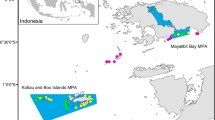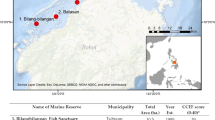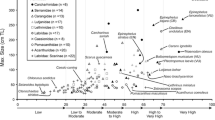Abstract
We examine the influence of reserve size and boundary length on the relative rate of fish density change in reserves versus fished reference reefs for three exploitable-sized reef fish categories: (1) combined fish (34 species of Haemulidae, Lutjanidae, Serranidae, and hogfish Lachnolaimus maximus); (2) Haemulidae (13 species); and (3) Lutjanidae (9 species). If reef habitat boundaries are highly permeable to fish movements then fish recovery within a reserve would be inversely proportional to: reserve perimeter (RP)/total reserve area (RA) (RP/RA). If, however, reef habitat boundaries are relatively impermeable barriers to fish movements, recovery within the reserve would be inversely proportional to: reserve boundary that intersects reef habitat (HI)/reef habitat area within the reserve (HA) (HI/HA). From 1994 to 2001 we monitored reef fishes within and outside of no-take marine reserves established in 1997 in the Florida Keys, USA. A significant majority of reserves had greater rates of density change than reference reefs for Lutjanidae and combined fish (22 of 24 reserves for both categories). Significantly higher rates of density change were found in ten reserves for Lutjanidae, two reserves for combined fish, and one reserve for Haemulidae. Reserves appeared to promote an increased density of exploitable fishes. A significant, negative, but weakly correlated relationship was found between the relative rate of density change (RDC) for combined fish and the HI/HA ratio. Reserve size and placement appeared to have a minimal effect upon RDC.


Similar content being viewed by others
References
Allison GW, Gaines SD, Lubchenco J et al (2003) Ensuring persistence of marine reserves: catastrophes require adopting an insurance factor. Ecol App 13:S8–S24
Ault JS, Bohnsack JA, Meester G (1998) A retrospective (1979–1996) multispecies assessment of coral reef fish stocks in the Florida Keys. Fish Bull 96:395–414
Ault JS, Smith SG, Luo J et al (2002) Baseline multispecies coral reef fish stock assessment for the Dry Tortugas. NOAA Technical Memorandum NMFS-SEFSC-487. p 117
Ault JS, Smith SG, Bohnsack JA (2005a) Evaluation of average length as an indicator of exploitation status for the Florida coral reef fish community. ICES J Mar Sci 62:417–423
Ault JS, Bohnsack JA, Smith SG et al (2005b) Towards sustainable multispecies fisheries in the Florida USA coral reef ecosystem. Bull Mar Sci 76(2):595–622
Ault JS, Smith SG, Bohnsack JA et al (2006) Building sustainable fisheries in Florida’s coral reef ecosystem: positive signs in the Dry Tortugas. Bull Mar Sci 78:633–654
Bohnsack JA (1998a) Application of marine reserves to reef fisheries management. Aust J Ecol 23:298–304
Bohnsack JA 1(998b) Marine reserves: Lessons from Florida. In: Yoklavich M (ed) Marine harvest refugia for west coast rockfish: a workshop. NOAA-TM-NMFS SWFSC 255:89–99
Bohnsack JA (1992) Reef resource habitat protection: the forgotten factor. In: Stroud RH (ed) Stemming the tide of coastal fish habitat loss. Mar Rec Fish 14:117–129
Bohnsack JA, Bannerot SP (1986) A stationary visual census technique for quantitatively assessing community structure of coral reef fishes. NOAA Technical Report NMFS 41, p 15
Bohnsack JA, McClellan DB, Harper DE et al (1999) Baseline data for evaluating reef fish populations in the Florida Keys, 1979–1998. NOAA Technical Memorandum NMFS-SEFSC 427, p 61
Buechner M (1987) Conservation in insular parks: simulation models of factors affecting the movement of animals across park boundaries. Biol Conserv 41:57–76
Carr MH, Reed DC (1993) Conceptual issues relevant to marine harvest refuges: examples from temperate reef fishes. Can J Fish Aquat Sci 50:2019–2028
Chapman MR, Kramer DL (2000) Movement of fishes within and among fringing coral reefs in Barbados. Environ Biol Fish 57:11–24
Collinge SK (1996) Ecological consequences of habitat fragmentation: implications for landscape architecture and planning. Landsc Urban Plan 36:59–77
DeMartini EE (1993) Modeling the potential of fishery reserves for managing Pacific coral reef fishes. Fish Bull 91:414–427
Edgar GJ, Barrett NS (1999) Effects of the declaration of marine reserves on Tasmanian reef fishes, invertebrates and plants. J Exp Mar Biol Ecol 242:107–144
Fish PA, Savitz J (1983) Variations in home range of Largemouth Bass, Yellow Perch, Bluegills, and Pumpkinseeds in an Illinois Lake. Trans Am Fish Soc 112:147–153
Fogarty MJ, Bohnsack JA, Dayton PK (2000) Marine reserves and resource management. In: Sheppard C (ed) Seas at the millennium: an environmental evaluation, Pergamon, Elsevier Science, New York, pp 283–300
Franklin EC, Ault JS, Smith SG et al (2003) Benthic habitat mapping in the Tortugas region, Florida. Mar Geod 26(1–2):19–34
Friedlander AM (2001) Essential fish habitat and the effective design of marine reserves: application for marine ornamental fishes. Aquar Sci Conserv 3:135–150
Gaines SD, Gaylord B, Largier JL (2003) Avoiding current oversights in marine reserve design. Ecol Appl 13:S32–S46
Gell FR, Roberts CM (2003) Benefits beyond boundaries: the fishery effects of marine reserves. Trends Ecol Evol 18:448–455
Grantham BA, Eckert GL, Shanks AL (2003) Dispersal potential of marine invertebrates in diverse habitats. Ecol Appl 13:S108–S116
Griffiths MH, Wilke CG (2002) Long-term movement patterns of five temperate-reef fishes (Pisces: Sparidae): implications for marine reserves. Mar Freshw Res 53:233–244
Halpern BS (2003) The impact of marine reserves: do reserves work and does reserve size matter? Ecol Appl 13:S117–S137
Halpern BS, Warner RR (2003) Matching marine reserve design to reserve objectives. Proc R Soc Lond B 270:1871–1878
Hilborn R, Stokes K, Maguire J et al (2004) When can marine reserves improve fisheries management? Ocean Coast Manage 47:197–205
Hixon MA, Carr MH (1997) Synergistic predation, density dependence, and population regulation in marine fish. Science 277:946–949
Hobson ES (1973) Diel feeding migrations in tropical reef fishes. Helgol Meersunters 24:361–370
Holland KN, Lowe CG, Wetherbee BM (1996) Movement and dispersal patterns of Blue Trevally (Caranx melampygus) in a fisheries conservation zone. Fish Res 25:279–292
Horwood JW (2000) No take zones: a management context. In: Kaiser MJ, de Groof SJ (eds) The effects of fishing on non-target species and habitats. Blackwell Science, Oxford, pp 302–312
Kupfer JA (1995) Landscape ecology and biogeography. Prog Phys Geog 19(1):18–34
Kramer DL, Chapman MR (1999) Implications of fish home range size and relocation for marine reserve function. Environ Biol Fish 55:65–79
Lowe CG, Topping DT, Cartamil DP et al (2003) Movement patterns, home range, and habitat utilization of adult kelp bass Paralabrax clathratus in a temperate no-take marine reserve. Mar Ecol Progr Ser 256:205–216
Lindeboom HJ (2000) The need for closed areas as a conservation tool. In: Kaiser MJ, de Groof SJ (eds) The effects of fishing on non-target species and habitats. Blackwell Science, Oxford, pp 302–312
McClanahan TR, Mangi S (2000) Spillover of exploitable fishes from a marine park and its effect on the adjacent fishery. Ecol Appl 10:1792–1805
Meester GA, Ault JS, Bohnsack JA (1999) Visual censusing and the extraction of average length as a biological indicator of stock health. Naturalista Siciliano 23(Suppl):205–222
Meester GA, Mehrotra A, Ault JS et al (2004) Designing marine reserves for fishery management. Management Sci 50(8):1031–1043
Murray S, Ambrose R, Bohnsack J et al (1999) No-take reserve networks: sustaining fishery populations and marine ecosystems. Fisheries 24(11):11–25
Murawski SA, Brown R, Lai HL et al (2000) Large-scale closed areas as a fishery-management tool in temperate marine systems: the Georges Bank experience. Bull Mar Sci 66:775–798
National Research Council (1999) Marine protected areas: tools for sustaining ocean ecosystems. National Academy Press, Washington, DC
Neigel JE (2003) Species-area relationships and marine conservation. Ecol Appl 13:S138–S145
Plan Development Team (1990) The potential of marine fishery reserves for reef fish management in the U.S. Southern Atlantic. NOAA technical memorandum. US Department of Commerce, Washington DC
Polacheck T (1990) Year round closed areas as a management tool. Nat Res Model 4:327–354
Rakitin A, Kramer DL (1996) Effect of a marine reserve on the distribution of coral reef fishes in Barbados. Mar Ecol Prog Ser 131:97–113
Roberts CM (2000) Selecting marine reserve locations: optimality versus opportunism. Bull Mar Sci 66:581–592
Roberts CM, Andelman S, Branch G et al (2003) Ecological criteria for evaluating candidate sites for marine reserves. Ecol Appl 13:S199–S214
Roberts CM, Bohnsack JA, Gell F et al (2001) Effects of marine reserves on adjacent fisheries. Science 294:1920–1923
Roberts CM, Branch G, Bustamante RH et al (2003) Application of ecological criteria in selecting marine reserves and developing reserve networks. Ecol Appl 13:S215–S228
Roberts CM, Hawkins JP (2000) Fully-protected marine reserves: a guide. World Wildlife Fund, Washington, DC
Roberts CM, Hawkins JP (1997) How small can a marine reserve be and still be effective? Coral Reefs 16:150
Rowley RJ (1994) Marine reserves in fisheries management. Aquat Conserv Mar Freshw Ecosyst 4:233–254
Russ GR, Alcala AC (1996a) Do marine reserves export adult fish biomass? Evidence from Apo Island, Central Philipines. Mar Ecol Prog Ser 132:1–9
Russ GR, Alcala AC (1996b) Marine reserves: rates and patterns of recovery and decline of large predatory fish. Ecol Appl 6:947–961
Russ GR, Alcala AC, Maypa AP (2003) Spillover from marine reserves: the case of Naso vlamingii at Apo Island, the Philippines. Mar Ecol Prog Ser 264:15–20
Sale PF, Doherty PJ, Eckert GJ et al (1984) Large scale spatial and temporal variation in recruitment to fish populations on coral reefs. Oecologia 65:191–198
Sale PF, Cowen RK, Danilowicz BS et al (2005) Critical science gaps impede use of no-take fishery reserves. Trends Ecol Evol 20:74–80
Samoilys MA (1997) Movement in a large predatory fish: coral trout, Plectropomus leopardus (Pisces: Serranidae), on Heron Reef, Australia. Coral Reefs 16:151–158
Shanks AL, Grantham B, Carr MH (2003) Propagule dispersal distance and the size and spacing of marine reserves. Ecol Appl 13:S159–S169
Simberloff D, Abele LG (1982) Refuge design and island biogeographic theory: effects of fragmentation. Am Nat 120:41–50
Stamps JA, Buechner M, Krishnan VV (1987) The effects of edge permeability and habitat geometry on emigration from patches of habitat. Am Nat 129:533–552
Turner MG (1989) Landscape ecology: the effect of pattern on process. Annu Rev Ecol Syst 20:171–197
U.S. Department of Commerce (2005) Florida Keys National Marine Sanctuary annual report July 1, 2004–June 30, 2005, p 30
U.S. Department of Commerce (1996) Florida Keys National Marine Sanctuary final management plan/environmental impact statement, vol 1, p 319
Williamson DH, Russ GR, Ayling AM (2004) No-take marine reserves increase abundance and biomass of reef fish on inshore fringing reefs of the Great Barrier Reef. Environ Conserv 31:149–159
Wu J, Hobbs R (2002) Key issues and research priorities in landscape ecology: an idiosyncratic synthesis. Landsc Ecol 17:355–365
Zeller DC (1997) Home range and activity patterns of the coral trout Plectropomus leopardus (Serranidae). Mar Ecol Prog Ser 154:65–77
Zeller DC, Russ GR (1998) Marine reserves: patterns of adult movement of the coral trout (Plectropomus leopardus (Serranidae)). Can J Fish Aquat Sci 55:917–924
Acknowledgments
A. B. is very grateful for support by an NRC post-doctoral fellowship. We thank the anonymous reviewers for improving this manuscript. We thank all the coral reef dive team members for their dedication in gathering data. This research was also supported by the NMFS Coral Reef Program (Grant no. NA17RJ1226).
Author information
Authors and Affiliations
Corresponding author
Rights and permissions
About this article
Cite this article
Bartholomew, A., Bohnsack, J.A., Smith, S.G. et al. Influence of marine reserve size and boundary length on the initial response of exploited reef fishes in the Florida Keys National Marine Sanctuary, USA. Landscape Ecol 23 (Suppl 1), 55–65 (2008). https://doi.org/10.1007/s10980-007-9136-0
Received:
Accepted:
Published:
Issue Date:
DOI: https://doi.org/10.1007/s10980-007-9136-0




